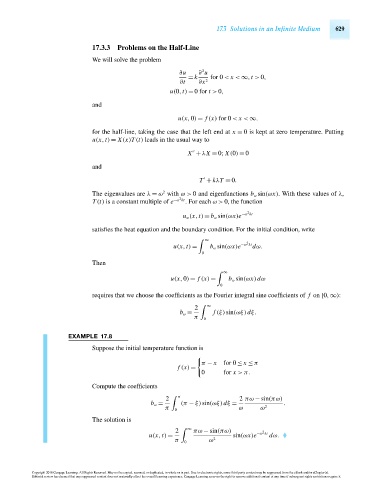Page 649 - Advanced_Engineering_Mathematics o'neil
P. 649
17.3 Solutions in an Infinite Medium 629
17.3.3 Problems on the Half-Line
We will solve the problem
2
∂u ∂ u
= k for 0 < x < ∞,t > 0,
∂t ∂x 2
u(0,t) = 0for t > 0,
and
u(x,0) = f (x) for 0 < x < ∞.
for the half-line, taking the case that the left end at x = 0 is kept at zero temperature. Putting
u(x,t) = X(x)T (t) leads in the usual way to
X + λX = 0; X(0) = 0
and
T + kλT = 0.
2
The eigenvalues are λ = ω with ω> 0 and eigenfunctions b ω sin(ωx). With these values of λ,
2
T (t) is a constant multiple of e −ω kt . For each ω> 0, the function
2
u ω (x,t) = b ω sin(ωx)e −ω kt
satisfies the heat equation and the boundary condition. For the initial condition, write
∞ 2
u(x,t) = b ω sin(ωx)e −ω kt dω.
0
Then
∞
u(x,0) = f (x) = b ω sin(ωx)dω
0
requires that we choose the coefficients as the Fourier integral sine coefficients of f on [0,∞):
2 ∞
b ω = f (ξ)sin(ωξ)dξ.
π 0
EXAMPLE 17.8
Suppose the initial temperature function is
π − x for 0 ≤ x ≤ π
f (x) =
0 for x >π.
Compute the coefficients
2 π 2 πω − sin(πω)
b ω = (π − ξ)sin(ωξ)dξ = .
π 0 ω ω 2
The solution is
2 ∞ πω − sin(πω) 2
u(x,t) = sin(ωx)e −ω kt dω.
π 0 ω 2
Copyright 2010 Cengage Learning. All Rights Reserved. May not be copied, scanned, or duplicated, in whole or in part. Due to electronic rights, some third party content may be suppressed from the eBook and/or eChapter(s).
Editorial review has deemed that any suppressed content does not materially affect the overall learning experience. Cengage Learning reserves the right to remove additional content at any time if subsequent rights restrictions require it.
October 14, 2010 15:25 THM/NEIL Page-629 27410_17_ch17_p611-640

